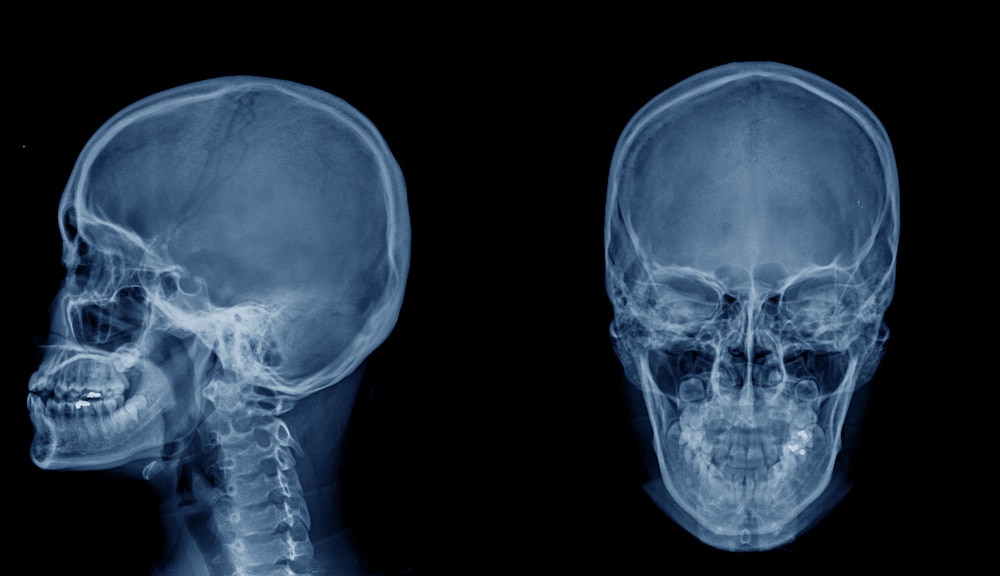Create a free profile to get unlimited access to exclusive videos, sweepstakes, and more!
When you get a concussion, your skull may get thicker and we're not sure why
Your bones are calling in reinforcements.

The characters in Leatherheads, the 2008 sports movie set in the world of professional football in 1920s America, barely look like they’re playing football at all, at least by modern standards. The game has changed considerably in the last century and nowhere is that more apparent than in the protective gear.
The movie takes its name from a common moniker for football players. That moniker, in turn, takes its name from the old timey helmets football players used to wear. Far from the robust brain cushions today’s players wear, these old helmets were little more than a slightly padded extra skin pulled over the head. They were certainly better than nothing, but probably not by much. Helmets have improved as we’ve continued to learn about the enduring consequences of traumatic brain injury.
Concussions, or so-called mild traumatic brain injuries — that’s a curious mishmash of words if we’ve ever heard one — are the most common brain injury and there’s mounting evidence that repeated blows to the head can result in long-term symptoms well after the injury itself has subsided. When those injuries happen, we think a lot about how the brain is impacted by forcefully bouncing around inside the skull. Considerably less consideration has been given to what happens to the skull at the same time.
RELATED: Thinking too much, for too long, builds up toxins in your brain
A team of scientists from various institutions in Australia set out to understand how the skull itself responds to mild brain injuries. The results of their study, published in the journal Scientific Reports, found that under the right conditions, the bones themselves will thicken over relatively short time periods.
It’s easy to forget that your bones are more than just inert scaffolding for the rest of your body. What we often think of as static tissues are alive; they have a dynamic relationship with the rest of your body. Your bones pay attention to the world around them, experiencing pressures from normal day-to-day activities, and from trauma. And they respond accordingly.
We know that even a single head trauma can have a long-lasting effect on the brain. They can result in impaired cognition, bruising, and swelling. The evidence also suggests that a brain injury leaves you extra vulnerable for a while. Researchers believe there is a period of up to three days during which an additional injury will exacerbate any existing symptoms. To find out, they set up an experiment using rats as a model and subjected them to head trauma consistent with a mild concussion. Rats were split into either the experimental group which received injuries and a control group which received “sham” treatments. Each animal underwent up to three rounds of injury or sham at 24-hour intervals.
While the force experience was less than that required to cause skull fracture, it might be that blunt trauma causes some skull deformation and triggers a repair response similar to a broken bone. Skull bone samples were collected from the rats at either two weeks or ten weeks after the final injury.
After two weeks, scientists noticed a slight increase in the thickness of the skull at the injury site, especially among rats who received multiple knocks to the head. In the samples collected ten weeks after the final injury, increased skull thickness was even more substantial. Interestingly, while new bone did grow at or near the site of the injury, researchers also found that marrow cavities in the bone hollowed out and lost density progressively after injury. The bone might be thicker than before, but it isn’t necessarily more robust or healthier.
That the skull gets thicker after injury makes a certain amount of intuitive sense. It’s reminiscent of something many of us heard growing up. There’s a common belief that when you break a bone, it grows back stronger than before at the break site. It’s almost a consolation prize for breaking your leg. You might spend the summer on the couch but at least you’ll have an indestructible leg once you’ve mended, right? Sadly, this is largely an urban legend but one which rests on a nugget of truth.
During the healing process, there’s a point at which a calcium bridge spans the break site. During this period, it’s possible that the specific bridge location could be stronger than typical bone. However, there’s a trade-off. The rest of the bone is losing mass because you’ve been laid up in bed for weeks, not using it. Overall, the bone is weaker and once the healing process is complete, even the break site returns to a strength more or less what it was before. So, does your bone grow back stronger after a break? Yes and no. It’s complicated.
The same is true of the skull. While the bone does grow thicker after repeated injuries, the vacated marrow cavities could negatively impact strength and long-term health. There are likely other variables we don’t yet know about, and researchers hope this may open up new avenues of research to help us better understand the consequences of brain injury, both in the moment and down the line.
They also caution against seeking out mild head injuries as a way of strengthening your skull. Hopefully, that goes without saying.


























